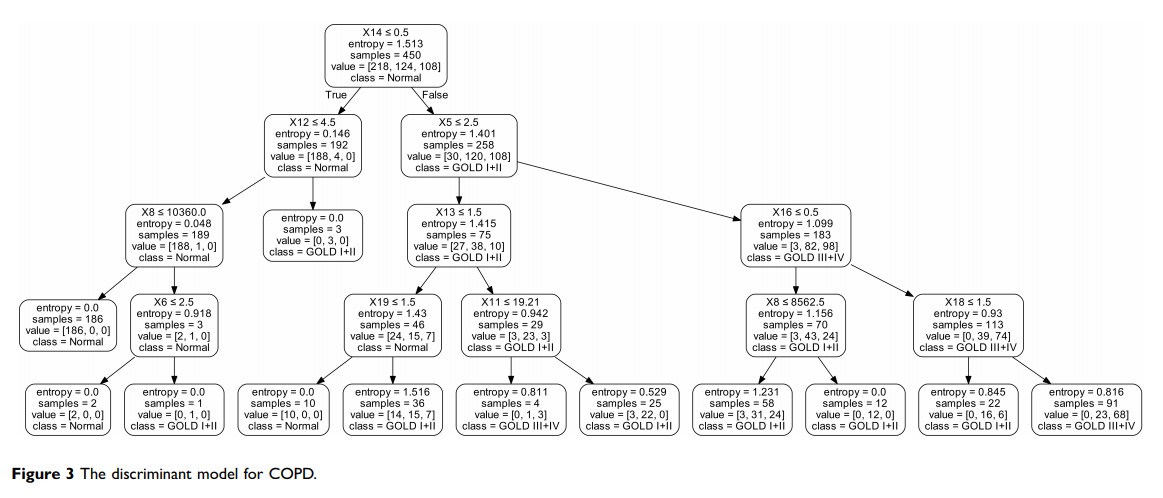108384
论文已发表
注册即可获取德孚的最新动态
IF 收录期刊
- 3.4 Breast Cancer (Dove Med Press)
- 3.2 Clin Epidemiol
- 2.6 Cancer Manag Res
- 2.9 Infect Drug Resist
- 3.7 Clin Interv Aging
- 5.1 Drug Des Dev Ther
- 3.1 Int J Chronic Obstr
- 6.6 Int J Nanomed
- 2.6 Int J Women's Health
- 2.9 Neuropsych Dis Treat
- 2.8 OncoTargets Ther
- 2.0 Patient Prefer Adher
- 2.2 Ther Clin Risk Manag
- 2.5 J Pain Res
- 3.0 Diabet Metab Synd Ob
- 3.2 Psychol Res Behav Ma
- 3.4 Nat Sci Sleep
- 1.8 Pharmgenomics Pers Med
- 2.0 Risk Manag Healthc Policy
- 4.1 J Inflamm Res
- 2.0 Int J Gen Med
- 3.4 J Hepatocell Carcinoma
- 3.0 J Asthma Allergy
- 2.2 Clin Cosmet Investig Dermatol
- 2.4 J Multidiscip Healthc

中国东北地区慢性阻塞性肺疾病初步筛查模型和识别模型的构建
Authors Li X, Guo Y, Li W, Wang W, Zhang F, Li S
Received 17 February 2020
Accepted for publication 12 June 2020
Published 31 July 2020 Volume 2020:15 Pages 1849—1861
DOI https://doi.org/10.2147/COPD.S250199
Checked for plagiarism Yes
Review by Single anonymous peer review
Peer reviewer comments 2
Editor who approved publication: Dr Richard Russell
Objective: The diagnosis of chronic obstructive pulmonary disease (COPD) is challenging, especially in the primary institution which lacks spirometer. To reduce the rate of COPD missed diagnoses in Northeast China, which has a higher prevalence of COPD, this study aimed to establish efficient primary screening and discriminant models of COPD in this region.
Patients and Methods: Subjects from Northeast China were enrolled from December 2017 to April 2019 from The First Hospital of China Medical University. Pulmonary function tests and questionnaire were given to all participants. Using illness or no illness as the goal for screening models and disease severity as the goal for discriminant models, multivariate linear regression, logical regression, linear discriminant analysis, K-nearest neighbor, decision tree and support vector machine were constructed through R language and Python software. After comparing effectiveness among them, the most optimal primary screening and discriminant models were established.
Results: Enrolled were 232 COPD patients (124 GOLD I–II and 108 GOLD III–IV) and 218 normal controls. Eight primary screening models were established. The optimal model was Y = − 1.2562– 0.3891X4 (education level) + 1.7996X5 (dyspnea) + 0.5102X6 (cooking fuel grade) + 1.498X7 (smoking index) + 0.8077X9 (family history)-0.5552X11 (BMI) + 0.538X13 (cough with sputum) + 2.0328X14 (wheezing) + 1.3378X16 (farmers) + 0.8187X17 (mother’s smoking exposure history during pregnancy)-0.389X18 (kitchen ventilation) + 0.6888X19 (childhood heating). Six discriminant models were established. The optimal model was decision tree (the optimal variables: dyspnea (x5), cooking fuel grade (x6), second-hand smoking index (x8), BMI (x11), cough (x12), cough with sputum (x13), wheezing (x14), farmer (x16), kitchen ventilation (x18), and childhood heating (x19)). The code was established to combine the discriminant model with computer technology.
Conclusion: Many factors were related to COPD in Northeast China. Stepwise logistic regression and decision tree were the optimal screening and discriminant models for COPD in this region.
Keywords: chronic obstructive pulmonary disease, screening, discriminant, severity, model
